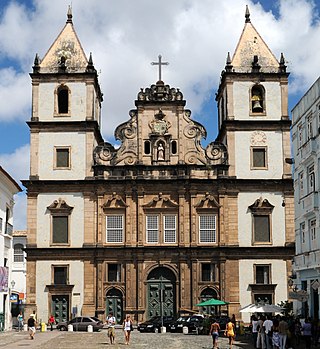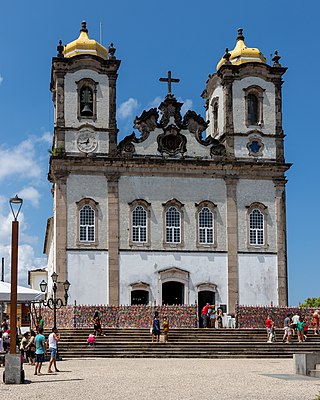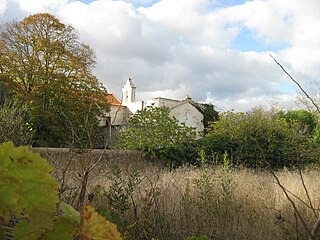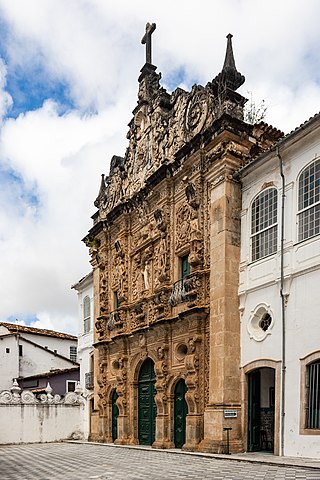
Cachoeira is an inland municipality of Bahia, Brazil, on the Paraguaçu River. The town exports sugar, cotton, and tobacco and is a thriving commercial and industrial centre.

The São Francisco Church and Convent of Salvador is located in the historical centre of Salvador, in the State of Bahia, Brazil. The ornate Church of the Third Order of Saint Francis sits adjacent to the convent. The friars of the Franciscan Order arrived in Salvador in 1587 and constructed a convent and church on the site. This structure was destroyed by the Dutch during the Dutch invasions of Bahia in the next century; Father Vicente das Chagas initiated the current structure in 1686, which was completed in the 18th century. The Franciscan church and convent have the largest number of azulejos, 55,000, of any church in Latin America.

The Church of Our Lord of Bonfim is the most famous of the Catholic churches of Salvador, in the State of Bahia, Brazil. It was built in the 18th century on the only line of hills in the Itapagipe Peninsula, in the lower town of Salvador. The church is the subject of intense religious devotion by the people of Salvador and is the site of a famous celebration held every year in January, the Festa do Senhor do Bonfim. The church is the Cathedral of the Roman Catholic Diocese of Bonfim. The church is noted for the Festa do Bonfim, held annually the second Thursday after Three Kings Day. The festival combines elements of both Catholicism and Candomblé. It was listed as a historic structure by the National Historic and Artistic Heritage Institute in 1938.

The Historic Center (US) or Centre of Salvador de Bahia in Brazil, also known as the Pelourinho or Pelo, is a historic neighborhood in western Salvador, Bahia. It was the city's center during the Portuguese colonial period and was named for the whipping post in its central plaza where enslaved people from Africa were publicly beaten as punishment for alleged infractions. The Historic Center is extremely rich in historical monuments dating from the 17th through the 19th centuries.

The Convent of Our Lady of Mount Carmel is a medieval carmelite convent and church complex in the civil parish of Lagoa in the municipality of Lagoa in the Portuguese Algarve. The original convent was all but destroyed in the 1755 Lisbon earthquake. After the extinction of the religious orders in Portugal in 1834, the property was taken over by a signeurial family which continued to provide church services.

The Church and Convent of Our Lady of Mount Carmel is an 18th-century Roman Catholic church in Cachoeira, Bahia, Brazil. It was constructed between 1688 and likely completed in 1773. The church is dedicated to Our Lady of the Rosary and is constructed in the Baroque style with a Rococo frontispiece. The church opens to Travessa Taváres, a broad avenue, with a view to the Paraguaçu River. The church is dedicated to Our Lady of Mount Carmel.

The Church of the Third Order of Saint Francis is an 18th-century Roman Catholic church in Salvador, Bahia, Brazil and seat of the Third Order of Saint Francis in Brazil. The church is one of the main elements of the Historic Center of Salvador and lies within the UNESCO World Heritage Site of the city. It was listed as a historic structure by National Institute of Historic and Artistic Heritage (IPHAN) in 1941. The church was constructed as an annex to the São Francisco Church and Convent. It is noted for its distinctive Plateresque-style façade, an example unique in Brazil. The writer Jorge Amado called the façade of the Third Order church "magnificent."

The Church of the Third Order of the Holy Trinity is an abandoned Roman Catholic church located in Salvador, capital of the Brazilian state of Bahia. First built as a chapel in 1733 and later expanded into its current structure in 1739, the church was abandoned by the Archdiocese of São Salvador in 1990. Located in the decadent Água de Meninos neighbourhood, the church was abandoned for a whole decade until it was reclaimed by a group of homeless people known as the Trinity community in 2000.

The Church of the Third Order of Our Lady of the Rosary of the Black People is an 18th-century Roman Catholic church in Salvador, Bahia, Brazil. Construction of the church took almost 100 years. It is dedicated to Our Lady of the Rosary and belongs to the Archdiocese of São Salvador da Bahia. The church was listed as a historic structure by National Institute of Historic and Artistic Heritage (IPHAN) in 1938 and is part of the Historic Center of Salvador UNESCO World Heritage Site.

The Parish Church of Our Lady of Pilar is an 18th-century Roman Catholic church located in Salvador, Bahia, Brazil. It includes a cemetery, constructed in the Neoclassical parallel to the nave of the church. The interior of the church has an extensive set of azulejo tiles in the rococo style. The historian Carlos Ott dated them to the late 18th century, and stated that they appear to be the work of the Juncal workshop in Portugal. The stonework of the church is in lioz stone, imported from Lisbon at great expense. The art historian Germain Bazin describes the church as a "refinement of forms", due to its long, narrow nave and lack of corridors in the nave.

The Church and Convent of Saint Antony and Chapel of the Third Order is a 17th-century Roman Catholic church and convent located in São Francisco do Conde, Bahia, Brazil. Construction began in 1618 and was completed in 1633, 64 years before the founding of the municipality of São Francisco of the Conde in 1697. The interior of the church was renovated in 1718 and the original alters were removed, but the façade was retained. The Convent of Saint Anthony is the only religious structure in Latin America with azulejos depicting all sixteen miracles of Saint Anthony, the patron of the church and convent. The painting on the ceiling of the nave is attributed to José Joaquim da Rocha, who also painted the ceiling of Basilica of the Immaculate Conception in Salvador. It could also be the work of his student, Veríssimo de Souza Freitas.

The Church of the Third Order of Penitence of Saint Dominic of Osma is an 18th-century Roman Catholic church in Salvador, Bahia, Brazil. The church is dedicated to Saint Dominic, a Castilian priest and founder of the Dominican Order. It belongs to the Roman Catholic Archdiocese of São Salvador da Bahia. It occupies the north-west perimeter of the Terreiro de Jesus, opposite the Cathedral Basilica of Salvador. The church was listed as a historic structure by the National Historic and Artistic Heritage Institute in 1938.

The Chapel of the Holy Body is an 18th-century Roman Catholic church in Salvador, Bahia, Brazil. The church is dedicated to Saint Peter González; Saint Joseph is also venerated by the congregation. It belongs to the Roman Catholic Archdiocese of São Salvador da Bahia. The church is the seat of the Brotherhood de São José do Corpo Santo, which also manages the property. A large scale image of Our Father of Salvation attributed to Francisco das Chagas is located in the church.

The Church and Convent of Our Lady of Mount Carmel is a 17th-century Roman Catholic church and former convent in Salvador, Bahia, Brazil. The church is dedicated to Our Lady of Mount Carmel. The complex is adjacent to the Church of the Third Order of Mount Carmel. The Church and Convent of Our Lady of Mount Carmel was listed as a historic structure by National Institute of Historic and Artistic Heritage (IPHAN) in 1938 and is part of the Historic Center of Salvador UNESCO World Heritage Site.

The Parish Church of Our Lady of Purification is an 18th-century Roman Catholic church located in Santo Amaro, Bahia, Brazil. The church is dedicated to Blessed Virgin Mary and belongs to the Roman Catholic Archdiocese of São Salvador da Bahia. Its construction is dated to 1706. The church was listed as a historic structure by the National Historic and Artistic Heritage Institute in 1958.

The Church of the Third Order of the Blessed Virgin Mary of Our Lady of the Conception of the Mulatto Brothers is an 18th-century Roman Catholic church and former convent in Salvador, Bahia, Brazil. The church was constructed in a neighborhood formerly occupied by mixed-race and Afro-Brazilian artisans. The exterior of the church has an elaborate roccoco pediment and towers; the interior of the church has a Baroque-style ceiling painting in the nave and neoclassical side altars and chancel. The name of the church, boqueirão, refers to a large slope and trench constructed between the high city and low city of Salvador; it served as a defense of the city against foreign invasion. It was listed as a historic structure by the National Historic and Artistic Heritage Institute in 1951.

José Teófilo de Jesus was a Brazilian painter and gilder. He is the most noted representative of the Escola Baiana or Bahian School of painting. His work was eclectic, characterized by the passage from the Baroque to the Rococo, with reference to Neoclassical traits. De Jesus was of pardo, or mixed ethnic ancestry and lived into his nineties; little else is known of his life. His production was apparently vast, but many of his works are only identified by oral tradition. Although he is known as one of the great names of the Brazilian Baroque, and one of its final artists, details of his life and a full account of his works remain unclear.

The Church and Convent of the Third Order of Our Lady of Carmo is located in the Brazilian state capital of João Pessoa. Situated in the Historic Center of João Pessoa, in Dom Adauto Square, comprises an architectural complex, built by the Carmelites, composed of the Church of Our Lady of Carmo, the Episcopal Palace, both built in the century (Iphaep), and the Church of Santa Teresa de Jesus of the Terceira do Carmo Order, dating from the 18th century and registered by the Institute of National Historical and Artistic Heritage (Iphan).

The Church of the Third Order of Mount Carmel is an 18th-century Roman Catholic church in São Cristóvão, Sergipe, Brazil. It, along with the First Order Church and Convent of Mount Carmel form a large-scale religious complex at the south of the cidade alta, or upper city, of the town. The Third Order church was completed in 1739 after the First Order Church and Monastery; the two form a harmonious whole. The Carmlite complex is part of the UNESCO World Heritage Site of São Francisco Square; it was separatedly listed as a historic structure by the National Institute of Historic and Artistic Heritage (IPHAN) in 1941.

José Joaquim da Rocha was a Brazilian painter, engraver, gilder and restorer. His entire production was in the field of religious art, with the Catholic Church as his exclusive patron. He left numerous works of a scholarly character, moving away from the popular tradition that was common during the colonial period. Although his work has many moments of high level, it is uneven, partly because, since he became recognized, he always had many disciples and apprentices to assist him, to whom he delivered large portions of the work, and partly because of the use, as inspiration, of a varied iconography in engraving of irregular quality. Both practices were, however, common at the time.























